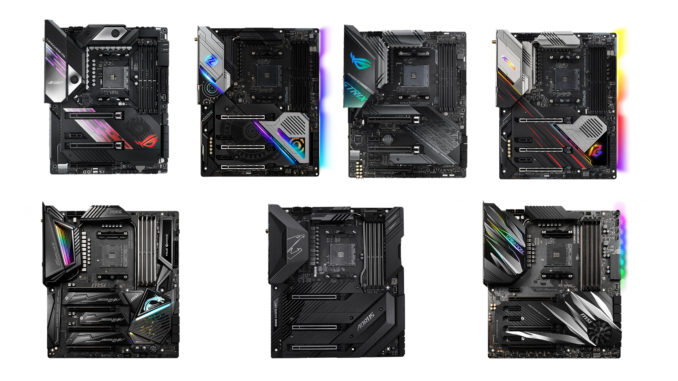
With Ryzen 3000 a new motherboard generation is coming. The start is made by models with the X570 high-end chipset. We compare all motherboards.
Going High with X570 and PCIe 4.0
With the X570 chipset, AMD has also introduced a new chipset for the upcoming Ryzen 3000 processors. The company packed in a lot of new things. The chipset is an in-house development and thus does not come from ASMedia, as it was the case before. One of the reasons for this is the use of PCIe 4.0, one of the new main features of Ryzen 3000. The X570 chipset also masters PCIe 4.0, which is mainly due to the fact that the chipset is a kind of second use of the management dies, which are located directly on the new processor package. AMD has only deactivated memory management for the chipset. The chipset is connected to the processor with four PCIe 4.0 lanes and offers 16 PCIe 4.0 lanes. This brings a total of 40 Lanes of the new, faster standard to motherboards with X570. However, the new chipset also has one disadvantage: a fan is installed on all motherboards. The only exception is the X570 Aorus Xtreme from Gigabyte, which uses a completely passive cooler. A special solution is the ASRock X570 Aqua, which cools the chipset via a full-cover water block.
AMD has also redefined itself in terms of price with the X570 motherboards. This generation has an exceptionally large number of high-end models with X570 chipsets. This is because AMD no longer wants to be the budget alternative to Intel. The high prices for almost all models are confirmed by a leaked price list from Asus and listed motherboards in a Danish shop. However, this is not necessarily negative. Especially enthusiasts get their money’s worth with the new models and get a lot of additional benefits. Many motherboards already come with the new WiFi 6 standard, USB 3.2 Gen 2 and even Thunderbolt 3. Due to many lanes, even the cheaper models are usually equipped with two fully connected M.2 slots with PCIe 4.0 speed, some motherboards even with three. It is also pleasing that many manufacturers rely on pre-installed I/O shields.
With Ryzen 3000, AMD finally takes over the scepter again in the high-end area. Fortunately, this is also reflected in the motherboards, which were rather neglected in the first two generations. Two weeks before the market launch of Ryzen 3000 we collected and compared all motherboards for you. And there were a few surprises.
ASRock focuses on high-end and special solutions
ASRock will be present with 10 motherboards for the start of X570. Some were already presented at Computex 2019, but only the X570 Taichi and the X570 Phantom Gaming X can be found on the ASRock website. The company ends the Fatal1ty series and replaces it with the already well-known Phantom Gaming brand. Also the recently introduced Steel Legend series gets an offshoot with X570 chipset. There is also a line that ASRock calls “Creator”. The Extreme 4 and Pro 4 series will stay too.
Taichi- and Phantom Gaming as high-end variants, X570 Aqua with full-cover water block
The Taichi series, which has become very popular in recent years, is still on board. With the ASRock X570 Taichi, ASRock has a true flagship in its program. Three mechanical PCIe x16 slots are available that can be used in x16/x0/x0, x8/x8/x0 or x8/x4/x4 configurations. Additionally, there are also two PCIe 4.0 x1 slots. ASRock uses three fully connected M.2 ports and eight SATA III ports for storage. There is also WiFi with WiFi 6 standard, but ASRock has cut on the LAN port and unfortunately only uses a Gigabit Ethernet port. Instead, an internal connector for Thunderbolt 3 using an additional card from ASRock is installed. Three USB 3.2 Gen 2 ports are also integrated, one of them as an internal header, plus six built-in and two internal USB 3.2 Gen 1 ports. ASRock has slightly changed the design of the Taichi motherboards, which is otherwise rather grey-white. Now there is an eye-catching LED lighting and golden gearwheel elements. A full-cover cooler cools the three M.2 slots and is separated from the chipset cooler. On the back there is a steel backplate, not for cooling, but to improve stability. The power supply consists of 14 phases each with an 4 and 8-pin connector.

(Picture: ASRock) 
(Picture: ASRock) 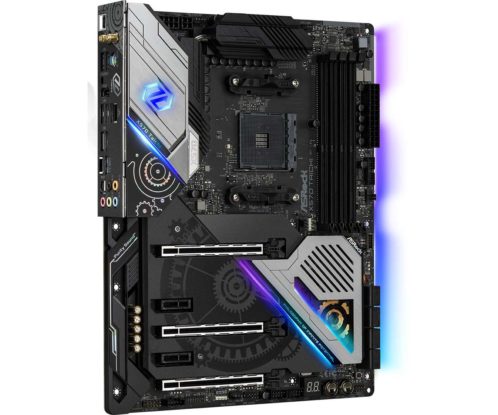
(Picture: ASRock) 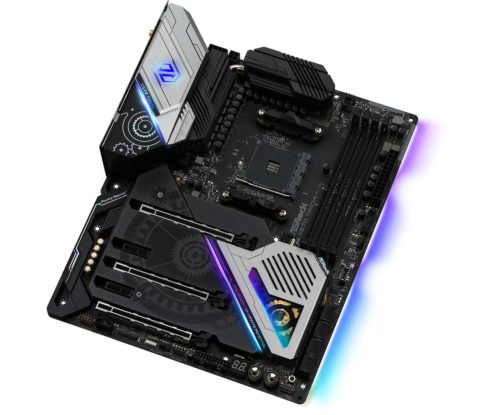
(Picture: ASRock) 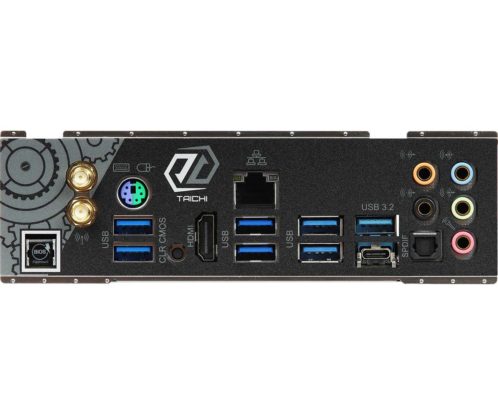
(Picture: ASRock) 
(Picture: ASRock) 
(Picture: PCBC/FM)
The second flagship is the ASRock X570 Phantom Gaming X. The design is almost identical to the layout of the Taichi model. However, the VRM coolers are silver instead of black. The chipset cooler is also slightly different and is equipped with an illuminated Phantom Gaming logo instead of a Taichi logo. The red stripes on the M.2 cooler are also striking. Technically, the two models also hardly differ from each other. The same PCIe slots and M.2 ports are available, and eight SATA III ports are installed. There are differences in the network connections. The Phantom Gaming X model has two Ethernet ports, one with Gigabit and one with 2.5G speed. Also with this board ASRock installs a WiFi 6 module and a Thunderbolt 3 header for an own expansion card. A steel backplate and the 14 phase design with a 4 and 8-pin connector are also included.

(Picture: ASRock) 
(Picture: ASRock) 
(Picture: ASRock) 
(Picture: ASRock) 
(Picture: ASRock) 
(Picture: ASRock) 
(Picture: PCBC/FM)
Another high-end flagship from ASRock is the ASRock X570 Aqua. The motherboard scores with an integrated full-cover water block that cools both the processor and the VRM phases as well as the chipset. So far, such a design is only found on Gigabyte with the Z390 Aorus Xtreme Waterforce. The X570 Water is the only motherboard besides the X570 Aorus Xtreme by Gigabyte that doesn’t need a chipset fan. The PCIe slots have the same structure as the Taichi and Phantom Gaming X model, but there are changes in the M.2 slots. The X570 Aqua has only two slots for M.2 SSDs. This could be due to the two biggest differences to the other high-end motherboards. A 10G Ethernet port is built in, in addition there are two Thunderbolt 3 ports, which are built in on the back as USB type C ports. Unfortunately, the number of phases is currently only a guess, as a power connection there is a 4-pin and an 8-pin connector. The ASRock X570 Aqua will have only 999 units, which are the most expensive X570 motherboards known today with a price tag of $999.

Creator for workhorses, Steel Legend and Extreme4 as upper middle class
In addition to the regular flagships, there is another model with above-average equipment. The ASRock X570 Creator is supposed to be especially suitable for workstations of creative people and therefore offers special features. It is comparably well equipped as the X570 Aqua. These include three mechanical PCIe x16 slots with the same connection, two fully connected M.2 slots, the 10G Ethernet port and the two Thunderbolt 3 connectors. In addition there are WiFi 6 and 10 USB 3.2 Gen 1 ports. In terms of design, ASRock has limited itself to the essentials and created a discreet board without a lot of RGB. Our information does not show how many phases ASRock builds in, but it could be about 12. One 4-pin and one 8-pin connector act as power connections.

The two motherboards X570 Steel Legend and X570 Extreme4 form the upper middle class at ASRock. The manufacturer differentiates the motherboards primarily in terms of design. Both offer the same features. Two PCIe 4.0 x16 slots with x16 and x4 connection are installed, plus three x1 slots and a M.2 port in E-key format, which is intended for retrofitting a WiFi module. SSDs can be integrated into the system via two M.2 ports and eight SATA III ports. A Gigabit Ethernet port is available as network connection. While the Steel Legend motherboard has RGB lighting on the I/O cover and chipset cooler, the Extreme4 is more discreet. The coolers for the M.2 SSDs look similar on both motherboards. The number of phases is still unknown, a 4-pin and an 8-pin connector serve as the power connection.
Pro4 in ATX- and mATX-format and Phantom Gaming 4 are the entry point
For the entry ASRock offers three motherboards. The X570 Pro4 and the X570 Phantom Gaming 4 are identical in layout and features. Only the design distinguishes the two motherboards a little. Thus, ASRock doesn’t have a built-in RGB lighting in the Pro4, but instead uses an M.2 cooler, which is not available in the Phantom Gaming 4. This comes in the typical Phantom Gaming design and discreet RGB lighting. Two mechanical PCIe x16 slots are available for expansions, of which one is connected with 16 and one with 4 lanes. For smaller devices there are two PCIe 4.0 x1 ports. Two M.2 SSDs with four PCIe 4.0 lanes are standard, plus an M.2 port in E-key format for retrofitting a WiFi module. Slower hard drives can also be connected via eight SATA III ports. Eight phases and an 8-pin connector are available for the power supply. There is also a micro ATX version of the X570 Pro4 called X570M Pro4. The motherboard misses practically no features except a PCIe 4.0 x1 slot and some USB ports.
ASRock X570 Phantom Gaming-ITX/TB3 has holes for Intel cooler and Thunderbolt 3
ASRock has come up with a different special solution for the manufacturer’s only Mini-ITX offshoot in the X570 series. The ASRock X570 Phantom Gaming-ITX/TB3 doesn’t come with the usual retention module for AMD coolers, but with holes for Intel coolers. Curiously enough, this could also be used to install a boxed cooler from Intel. ASRock justifies this by saying that this layout simply leaves more room for other components. Well equipped is the Phantom Gaming-ITX/TB3 for a Mini-ITX-Board in any case. In addition to the usual PCIe 4.0 x16 slot, there is an M.2 connector and four SATA III modules. WiFi according to WiFi 6 standard is also on board. There’s another network interface with the Gigabit Ethernet port. As the name suggests, the Phantom Gaming-ITX/TB3 also has a Thunderbolt 3 port on the back. Additionally there are two USB 3.2 Gen 2 ports and four USB 3.2 Gen 1 ports. The power supply is an 8-pin connector that supplies 10 phases. The chipset cooler is also special, because it’s attached to the motherboard like a wedge.
Asus offers 12 motherboards of all series
Asus is continuing to expand the series it has used in recent years. Compared to the last few years, there are significantly more motherboards at the launch. The series have changed a bit.
TUF series
The Ultimate Force motherboards (TUF) are the entry level for gamers. Asus offers two models to start with, the Asus TUF Gaming X570-Plus and the Asus TUF Gaming X570-Plus (Wi-Fi). The only difference between the two models is the built-in WiFi chip in the Wi-Fi model. Two mechanical x16 slots are installed, of which only one is connected with 16 PCIe 4.0 lanes. Two M.2 slots are connected with four PCIe 4.0 lanes. slower storage devices can be connected with eight SATA III ports. In addition to the dark design with yellow highlights, there is of course also a modest RGB lighting. The power supply is a 12+2-phase design with one 4-pin and one 8-pin connector.
Prime and WS Series
Parallel to the TUF series there is the Prime series, which is primarily intended for work computers and workstations. There are two models as well: the Asus Prime X570-P and the Asus Prime X570-PRO. The X570-P is the entry-level model and doesn’t have some design elements, but of course there are also technical differences. The Pro model has three PCIe 4.0 x16 slots, two of them are connected to either one 16 or two eight PCIe 4.0 lanes. The third slot is only connected with four lanes. There are also three x1 slots. The X570-P, on the other hand, has only one fully connected PCIe 4.0 x16 port, the second one only gets four lanes. Three x1 ports are also available. However, the two motherboards have the same storage connections. There are two fully connected M.2 slots each, plus six SATA III ports. Asus also carries on with the typical design of the Prime series. So both motherboards have white or light grey elements. Both motherboards have RGB lighting, further RGB LEDs can be connected via three headers. For the power supply, both boards use a 4-pin and an 8-pin connector, the X570-P a 12 phase and the X570-PRO a 14 phase design.

(Picture: Asus) 
(Picture: Asus) 
(Picture: Asus) 
(Picture: Asus) 
(Picture: Asus) 
(Picture: Asus) 
(Picture: Asus) 
(Picture: Asus)
A special motherboard is the Asus Pro WS X570-ACE. With it Asus also has a model in its portfolio that completely excludes any gaming features, lighting or design. The motherboard is completely black apart from the connection ports. Also technically there are some specialities. There are three PCIe x16 ports, all three of them are connected parallel with eight lanes. There is only one x1 port. Another special solution is the storage connection. Two M.2 slots are available, but only one of them is connected to four PCIe 4.0 lanes. The second one comes with two PCIe 4.0 lanes. There is also a U.2 port, which is connected with four PCIe 3.0 lanes. Also there are four SATA III ports. You can find two Gigabit Ethernet ports and five USB 3.2 Gen 2 ports on the back. The power supply is provided by 14 phases, but only one 8-pin connector.

(Picture: Asus) 
(Picture: Asus) 
(Picture: Asus) 
(Picture: Asus) 
(Picture: Asus) 
(Picture: Asus) 
(Picture: Asus)
ROG Strix Series
For the sophisticated gamer there is also the ROG Strix series from Asus. There are three models to start with: the Asus ROG Strix X570-F Gaming, the Asus ROG Strix X570-E Gaming as a better equipped version and the Asus ROG Strix X570-I Gaming as the only Mini-ITX motherboard. There is currently no technical data on the X570-I Gaming, but the cooling design for the chipset is particularly interesting. It is connected to the coolers of the VRM phases and the double M.2 slot. Mini fans should actively provide better cooling. The two “large” models also use an active chipset cooler. However, this is so cleverly hidden behind a cooling grille that you won’t notice the fan.

(Picture: Asus) 
(Picture: Asus) 
(Picture: Asus) 
(Picture: Asus) 
(Picture: Asus) 
(Picture: Asus) 
(Picture: Asus) 
(Picture: Asus) 
(Picture: Asus) 
(Picture: Asus) 
(Picture: Asus) 
(Picture: Asus) 
(Picture: Asus) 
(Picture: Asus) 
(Picture: Asus) 
(Picture: Asus) 
(Picture: Asus)
Of course, the motherboards also offer a lot of technical features. Asus again uses three mechanical x16 slots, of which one is connected with 16 lanes or alternatively two with eight lanes, and the third is connected with four lanes. There are two x1 slots. For storage, there are two M.2 slots with four PCIe 4.0 lanes installed, plus eight SATA III ports in addition. While the X570-F has only one Gigabit Ethernet port installed, the X570-E offers one Gigabit and one 2.5G Ethernet port. Only the X570-E also offers wireless support with a WiFi 6 controller and Bluetooth 5.0. In terms of design, the two motherboards are virtually identical again. The black Republic of Gamers design is well-known. Of course, there is also a built-in RGB lighting, as well as four headers for additional elements. Both motherboards have a power supply with 16 phases and one 4 and one 8-pin connector.
ROG Crosshair VIII-Series
The Top of the Line series at Asus is still called ROG Crosshair. Meanwhile a VIII stands for the eighth generation behind the name. Asus has generously expanded the series. So there used to be only one ROG Crosshair Hero model, but with the X570 chipset there are also the Formula and Impact models. There is also a Wi-Fi version of the Hero. All PCIe slot models are the same. There are three mechanical x16 slots, the first two can be connected either once with 16 or twice with 8 lanes. The third slot only gets four lanes, plus one x1 slot. For the storage there are two M.2 slots with full PCIe 4.0 x4 connection and eight SATA III ports. While both Hero models come with one Gigabit and one 2.5G Ethernet port each, the Crosshair VIII Formula has one Gigabit and one 5G Ethernet port. Interestingly enough, you have to cut back on the most expensive motherboard when it comes to wireless support. It only supports Wi-Fi 802.11-ac, while the Asus ROG Crosshair VIII Hero (Wi-Fi) already offers WiFi 6. On the other hand, they both offer Bluetooth 5.0.

(Picture: Asus) 
(Picture: Asus) 
(Picture: Asus) 
(Picture: Asus) 
(Picture: Asus) 
(Picture: Asus) 
(Picture: Asus) 
(Picture: Asus) 
(Picture: Asus)
In terms of design, Asus once again relies on the familiar design elements of its Republic of Gamers series. The ROG Crosshair VIII Formula has a RGB lighting graphic and an OLED display on the I/O cover, on which data or error codes can be displayed. Another special feature is the steel backplate and EKWB’s built-in water cooling blocks for the VRM phases. With all three boards there are of course also four headers for further RGB lighting. Speaking of VRM phases, both Formula and Hero use the same 16 phase design with a 4-pin and an 8-pin connector.
There is no exact technical data about the Asus ROG Crosshair VIII Impact. The motherboard comes in Mini-DTX format and is probably aimed mainly at extreme overclockers, since small motherboards have their advantages in this field. This motherboard also contains the SO-DIMM.2 port. Two M.2 SSDs can be connected with an additional card. For expansion there is a PCIe 4.0 x16 port.

Gigabyte has the only model without chipset fan
Gigabyte launches a total of eight X570 chipset motherboards for the Ryzen 3000 processors. The manufacturer was the only one to succeed in designing a motherboard without an active chipset fan. The Gigabyte X570 Aorus Xtreme’s extended cooling elements also allow passive cooling of the chipset. The other models, however, have a chipset cooler. Excitingly, Gigabyte also relies on the Aorus brand throughout – only one motherboard comes without it.
X570 Aorus – Highend
The top version of the X570 motherboards is the Gigabyte X570 Aorus Xtreme in E-ATX format. It comes with a noble, black design, in which Gigabyte doesn’t even have the otherwise so typical orange. An RGB-illumination is of course still available. The front is strongly occupied by a large cooling element that cools down the phases as well as the chipset and the M.2 SSDs. In other aspects too, the equipment is high-end. There are three mechanical x16 ports, of which two are connected either once with 16 or twice with eight lanes and one with four lanes from the chipset. For storage there are three fully connected M.2 slots and six SATA III ports. Another special feature is the 10G Ethernet port, which is installed in addition to the standard Gigabit Ethernet port. WiFi 6 is included as well. The power supply is realized via two 8-pin connectors and 16 phases. One level below is the Gigabyte X570 Aorus Master. It’s a very slightly slimmed down version of the Extreme, but with a slightly different design and active chipset cooler. There are only a few cuts in the Ethernet port, which is only equipped with 2.5G instead of 10G, as well as in the USB ports. But there is an additional PCIe 4.0 x1 port, and the X570 Aorus Master comes in ATX instead of E-ATX format. The power supply must be limited to 14 instead of 16 phases.

(Picture: Gigabyte) 
(Picture: Gigabyte) 
(Picture: Gigabyte) 
(Picture: Gigabyte) 
(Picture: Gigabyte) 
(Picture: Gigabyte) 
(Picture: Gigabyte) 
(Picture: Gigabyte) 
(Picture: Gigabyte) 
(Picture: Gigabyte) 
(Picture: Gigabyte) 
(Picture: Gigabyte)
A bit below there are the Gigabyte X570 Aorus Ultra and the X570 Aorus Pro. The last one is also available in a WIFI version with WiFi 6 support. The X570 Aorus Ultra has already installed this chip as standard. The PCIe configuration of the Aorus Ultra and Aorus Pro models is identical. Three mechanical x16 slots are installed, the first one is connected with 16 lanes. These 16 lanes are divided into eight lanes when the second slot is used. The bottom one is connected with four lanes, in addition there is one PCIe 4.0 x1 port. The first differences are in the storage connection. For example, the Aorus Ultra offers three M.2 slots connected with four PCIe 4.0 lanes each, while the Aorus Pro models have only two. All three motherboards offer six SATA III ports. The network connection on all three motherboards is only implemented with a Gigabit Ethernet port. The three motherboards also come with 12+2 phases and a 4- and 8-pin connector.

(Picture: Gigabyte) 
(Picture: Gigabyte) 
(Picture: Gigabyte) 
(Picture: Gigabyte) 
(Picture: Gigabyte) 
(Picture: Gigabyte) 
(Picture: Gigabyte) 
(Picture: Gigabyte) 
(Picture: Gigabyte) 
(Picture: Gigabyte) 
(Picture: Gigabyte)
X570 Aorus for Beginners, Mini-ITX and Entry Motherboard
The Gigabyte X570 Aorus Elite is the entry into the Aorus series. Although this comes in a similar design, it is technically much leaner. For example, the RAM can only be clocked up to DDR4-4000 instead of DDR4-4400 on all higher motherboards. The PCIe ports have a fully connected x16 port, including a chipset x16 port connected with four lanes and two x1 ports. There are two fully connected M.2 ports and six SATA III ports. The Internet connection runs via a Gigabit Ethernet connection. The power supply was realized with a 12+2-phase design with an 8-pin connector. The Gigabyte X570 Gaming X is the absolute entry to the X570 motherboards. The PCIe configuration is the same as for the Aorus Elite, and there are also two M.2 slots and a Gigabit Ethernet port. The main difference are the rather downsized USB ports. There are only a total of eight USB 3.2 Gen 1 ports, you won’t find Gen 2 ports or USB-C ports here. But there are six USB 2.0 ports. An integrated RGB lighting is also not used. Five ports for different RGB elements are used for this purpose. Power is supplied via a 10+2-phase design with an 8-pin connector.
Another special form is the Gigabyte X570 I Aorus Pro WIFI as Mini-ITX variant. As the name suggests, Gigabyte has also installed a WiFi 6 chip here, plus a Gigabit Ethernet connection. Naturally, only one PCIe 4.0 x16 port is installed, plus two fully connected M.2 slots, one on the front and one on the back. For the SSD on the front there is an active cooler, which also cools the chipset at the same time. The power supply consists of eight phases and an 8-pin connector.

(Picture: Gigabyte) 
(Picture: Gigabyte) 
(Picture: Gigabyte) 
(Picture: Gigabyte) 
(Picture: Gigabyte) 
(Picture: Gigabyte)
MSI focuses on high-end with X570
MSI also has a total of six motherboards in its portfolio for the launch of Ryzen 3000. It is noticeable that especially high-tier models are available for the start. Only two models could still pass as entry motherboards, the rest is well equipped above average.
MSI Godlike, Ace and Creation
With the series Godlike, Ace and Creation, the new naming scheme of MSI is also being introduced for the X570 motherboards. Included are three high-end models, which were not available for Ryzen processors before. The spearhead is the MSI MEG X570 Godlike. It is designed in E-ATX format and is the only known X570 motherboard with four mechanical PCIe x16 ports. The first three of these ports can be operated in the configurations x16/x0/x0, x8/x0/x8 or x8/x4/x4, the fourth port is connected via the chipset with four PCIe 4.0 lanes. For the storage there are three fully connected M.2 slots and six SATA III ports. If you need even more memory, you can use the included M.2 Xpander-Z Gen 4 to add two more M.2 SSDs with active coolers. Also included is a 10G Ethernet expansion card, because only a 2.5G and a Gigabit connection are installed as standard. There is also a WiFi 6 module. A 14+4+1 phase design and two 8-pin connectors ensure a stable power supply. The cooling design is also interesting. Thus MSI has connected all cooling elements, from the chipset cooler via the M.2 SSDs and the VRM coolers with heatpipes.
Here MSI uses the narrower ATX format. Interestingly, MSI has decided not to use the otherwise typical red in the design, but to use golden accents and, of course, RGB. Three mechanical x16 ports and two x1 ports are used as extensions. The two top ports are connected from the CPU with once 16 or twice 8 PCIe 4.0 lanes, the bottom port from the chipset with four lanes. Three fully connected M.2 slots and four SATA III ports are available for the storage. The network connection is either via cable via the 2.5G or Gigabit Ethernet connection or via WiFi with WiFi 6 support. The MEG X570 Ace gets power via 12+2+1 phases and two 8pin connectors. Here MSI also connects the coolers of the chipset and VRM with a heatpipe. However, you have to do without the two additional cards for 10G and two more M.2 SSDs.
The MSI Prestige X570 Creation is supposed to offer a special solution for creators. The motherboard comes in E-ATX format and some special features. The design is based on the already released brothers of the Creation line. The features are structured significantly in a different way, especially on the I/O side. As expansion slots, the Prestige X570 Creation offers two PCIe 4.0 x16 slots, one of them can be operated with 16 lanes or both with 8 lanes. Underneath there is another x16 slot, which is connected with four lanes. In addition, MSI has also installed four PCIe 2.0 x1 slots. For the storage there are two fully connected M.2 ports and six SATA III ports. The box also contains the M.2 Xpander-Z Gen 4 for two more M.2 SSDs. The I/O ports are very interesting. For the network, MSI uses one 10G and one Gigabit Ethernet port. With the included 10G adapter a Dual-10G connection is possible. In addition there is a built-in WiFi 6 chip. The equipment with USB interfaces is particularly opulent. MSI uses 14 USB 3.2 Gen 1 ports, 10 of them on the back. In addition, there are three USB 3.2 Gen 2 ports, one as type A and one as type C port on the back, one as internal port. 12+2+1 phases and two 8-pin connectors provide the power. Small detail: the 24 pin connector is angled.
MSI Gaming Pro Carbon, Gaming Edge and Gaming Plus
Apart from the expensive high-end motherboards, there is only little selection at MSI. An intermediate stage is the MSI MPG X570 Gaming Pro Carbon WiFi. The motherboard continues the previous Gaming Pro Carbon models and offers some features with a chic, black design and RGB highlights. For PCIe slots, the MPG X570 Gaming Pro Carbon offers two mechanical x16 slots, one of them is connected to 16 lanes. The other one uses four lanes from the chipset. There are also two PCIe 3.0 x1 slots. For storage, MSI relies on two M.2 slots with full PCIe 4.0 connectivity and six SATA III ports. WiFi 6 is also built in as standard, but later there will probably also be a version without a WiFi module. In addition, there is a Gigabit Ethernet port. The power supply is designed with 12 phases and one 4-pin and one 8-pin port. Below the Gaming Pro Carbon is the MSI MPG X570 Gaming Edge WIFI. It brings almost the same configuration of PCIe slots (one more x1 port is installed), but has a disadvantage with the M.2 ports. Only one of the two slots is connected with four PCIe 4.0 lanes, the second slot has to get by with four PCIe 3.0 lanes. The six SATA III ports have remained. There are also some limitations with the WiFi chip. This only supports WiFi-AC, no WiFi 6. Additionally another Gigabit Ethernet chip is built in. The power supply is provided by 12 phases and one 8-pin and one 4-pin connector.

(Picture: MSI) 
(Picture: MSI) 
(Picture: MSI) 
(Picture: MSI) 
(Picture: MSI) 
(Picture: MSI) 
(Picture: MSI) 
(Picture: MSI) 
(Picture: MSI) 
(Picture: MSI) 
(Picture: MSI)
The MSI MPG X570 Gaming Plus is MSI’s absolute entry into the X570 motherboards. It also comes with two x16 slots, of which only one is connected with 16 PCIe 4.0 lanes. The second has only four Lanes from the chipset. In addition there are three PCIe 3.0 x1 ports. Like the MPG X570 Gaming Edge WIFI, the Gaming Plus model offers two M.2 slots, only one of them is connected to four PCIe 4.0 lanes. The second comes with four PCIe 3.0 lanes, besides that there are six SATA III ports. There is no WiFi on the motherboard, only Gigabit Ethernet. MSI don’t use built-in RGB lighting either, but ports for controlling external RGB components are of course available. The power supply uses 12 phases and one 4-pin and one 8-pin connector.


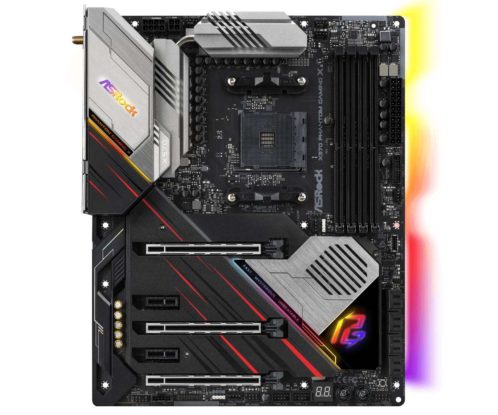



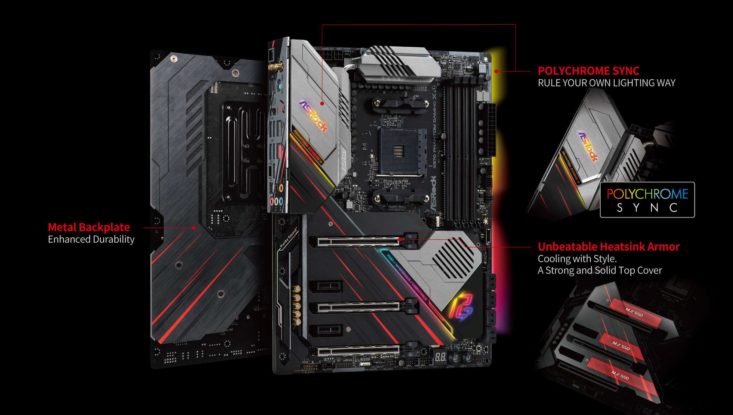


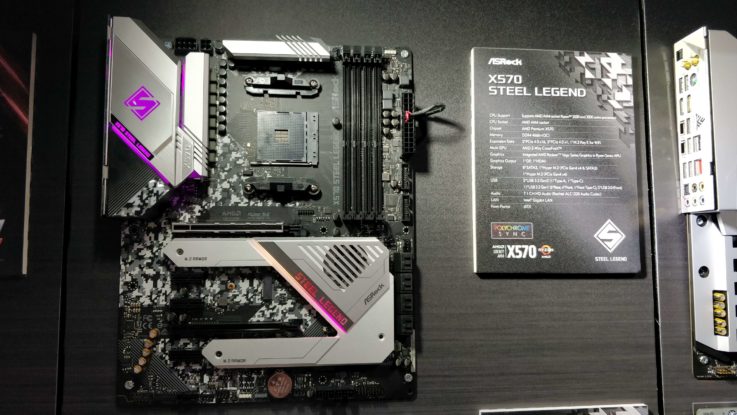
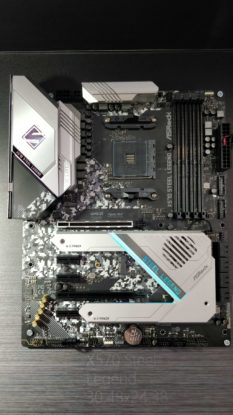

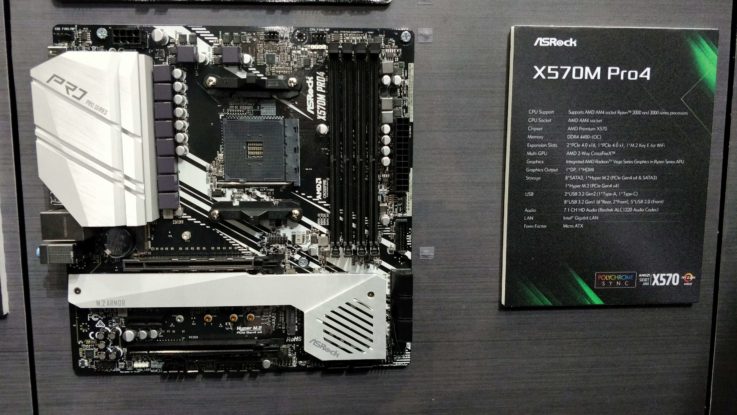








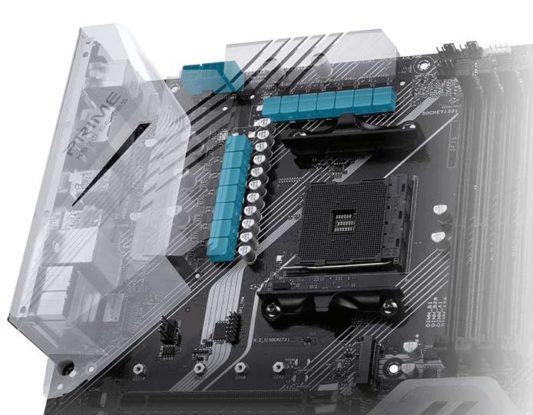
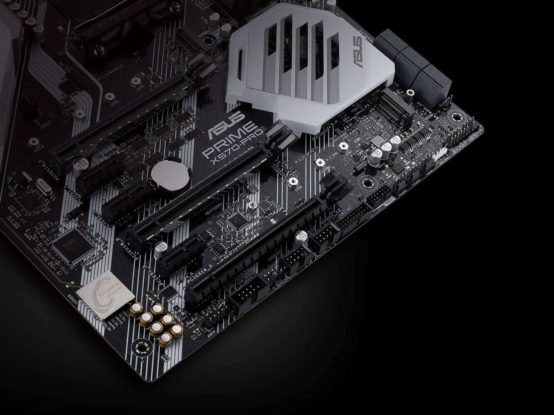

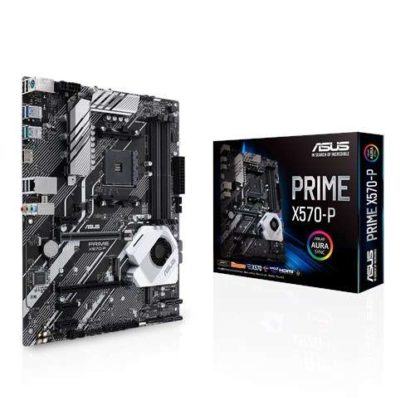
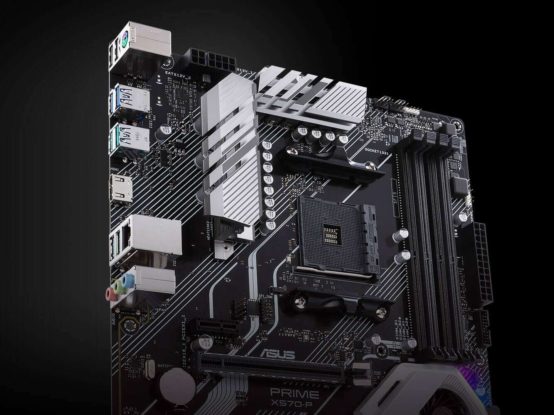









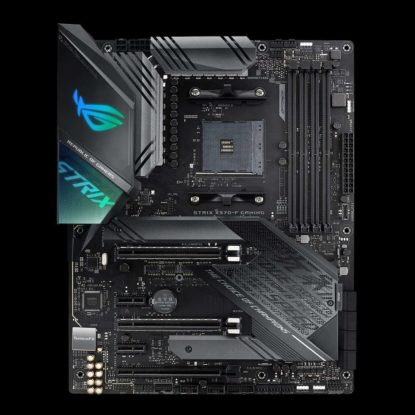


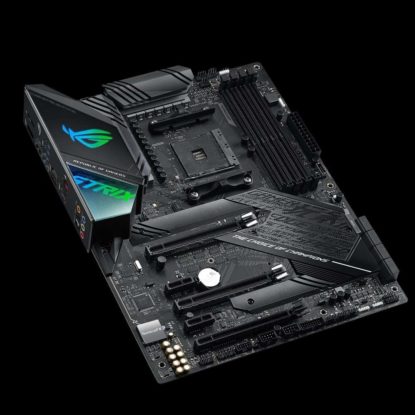
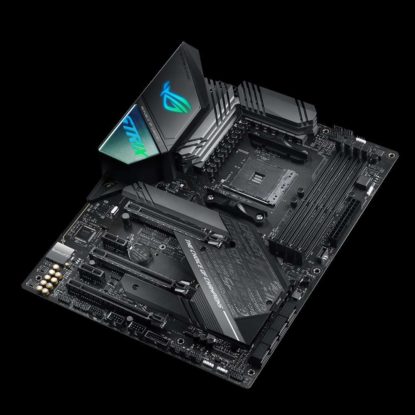




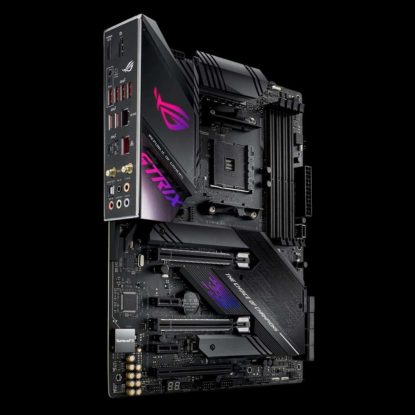
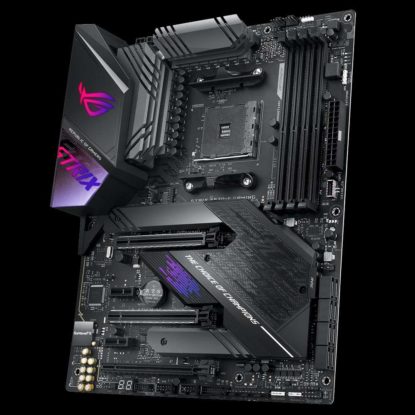

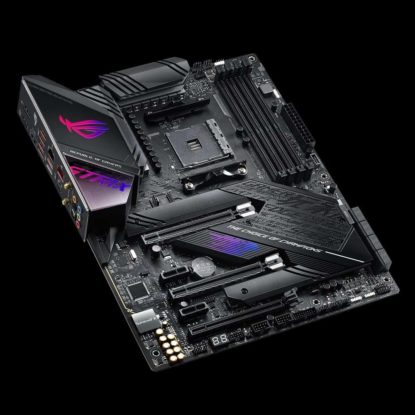

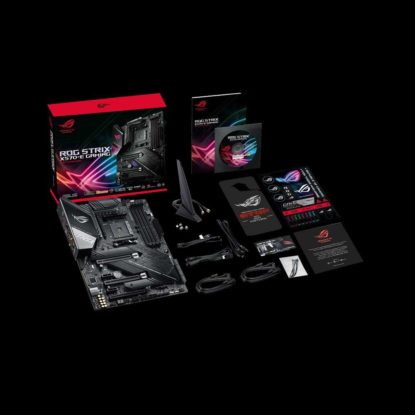
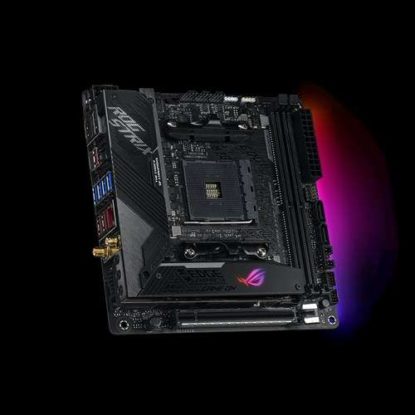










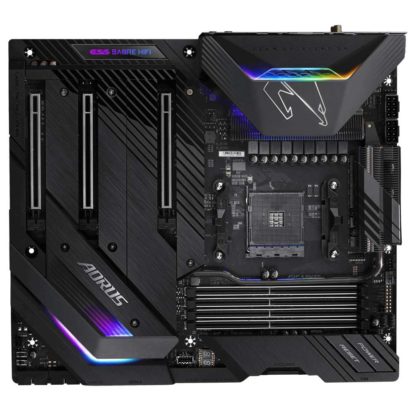
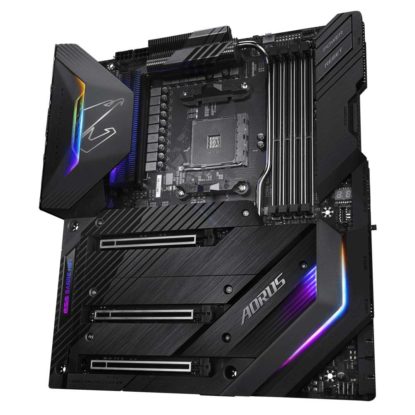






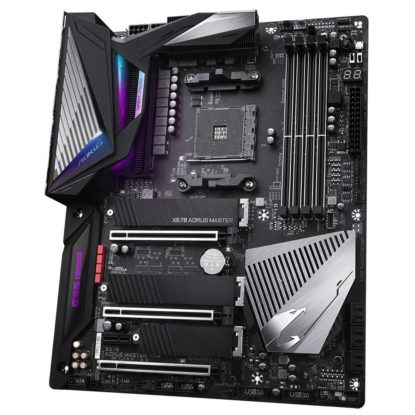


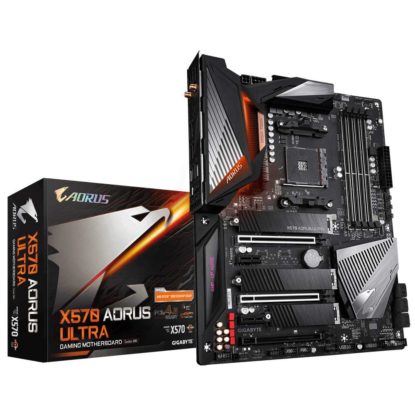

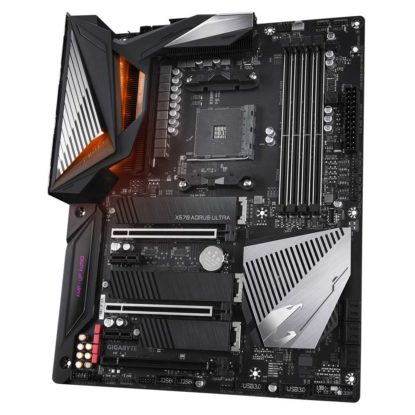

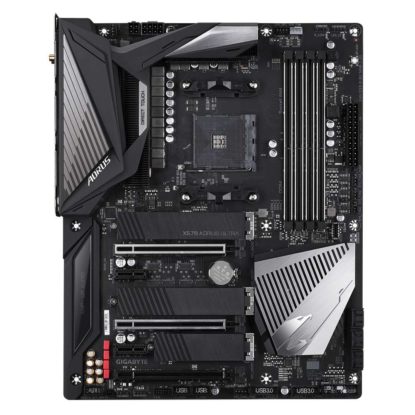






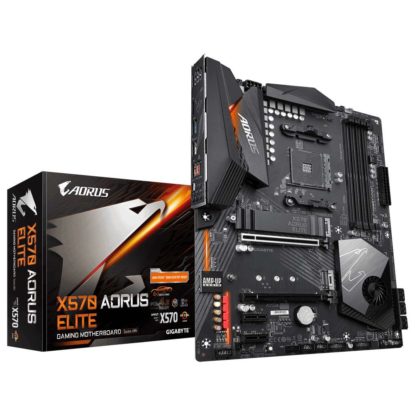






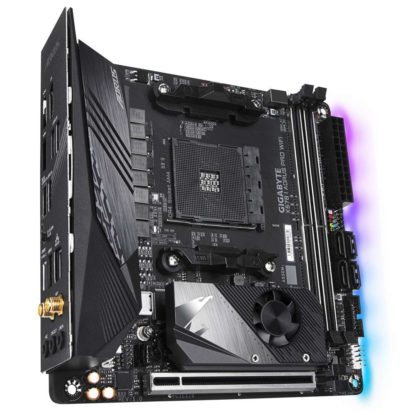

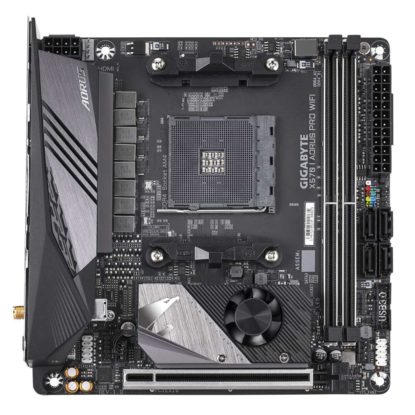



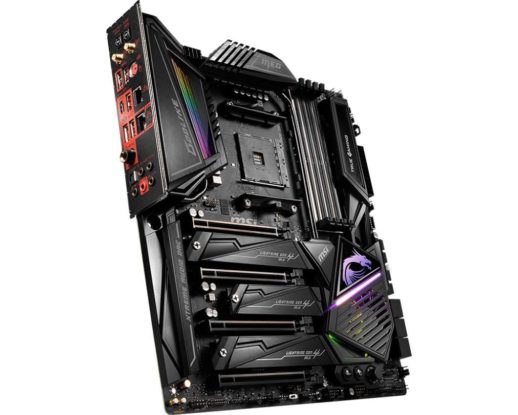
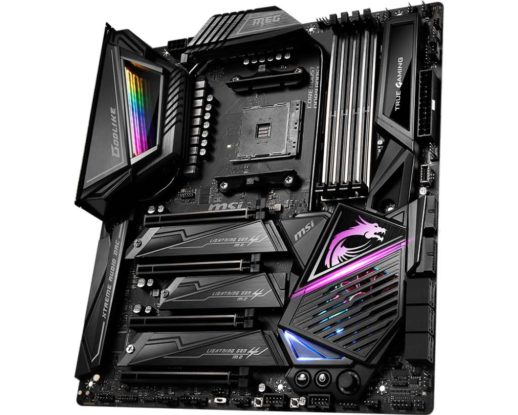

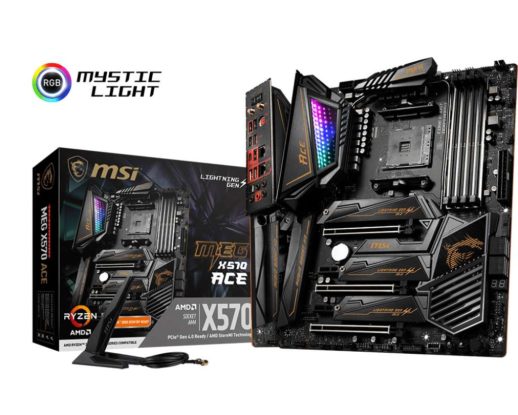

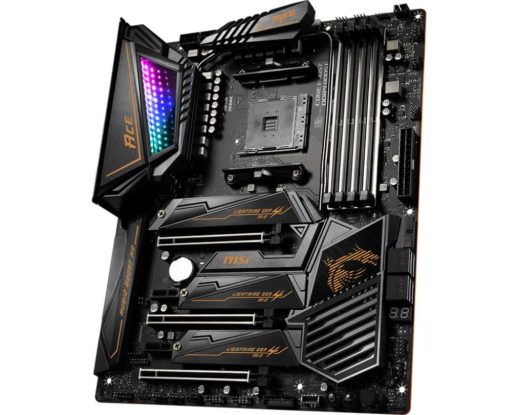
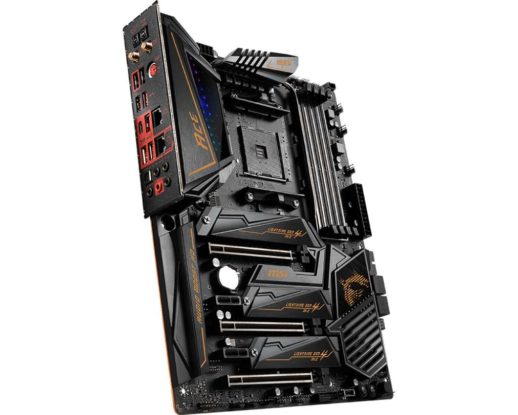








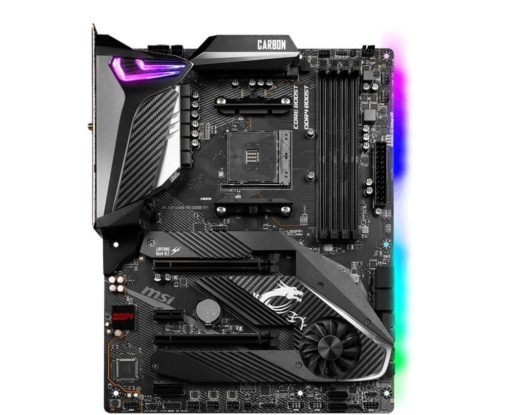

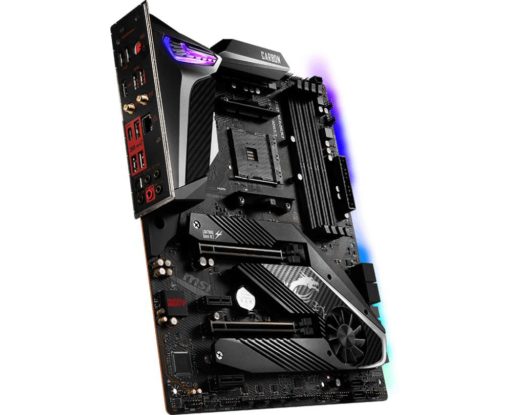


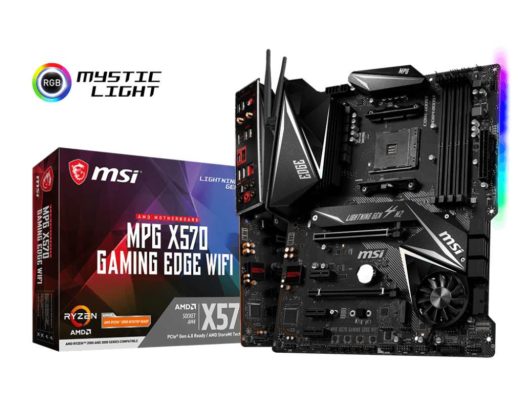

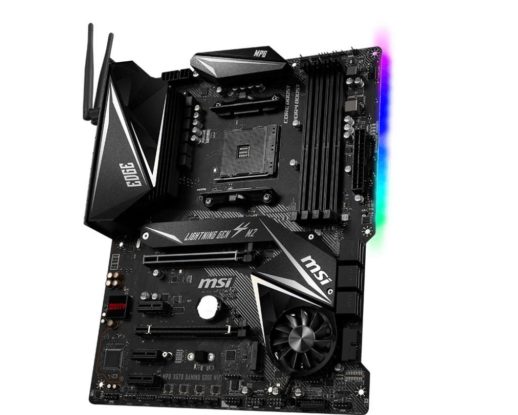

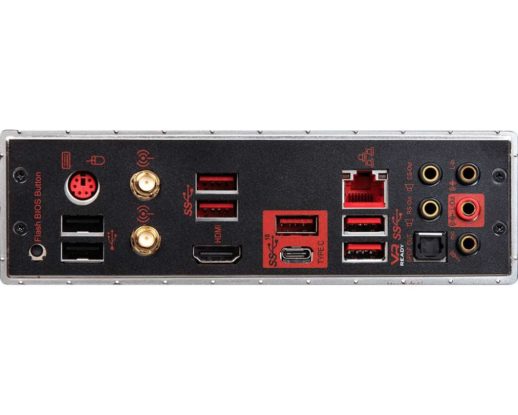
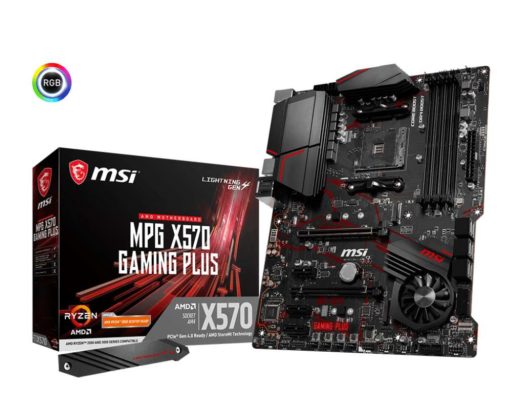





What about memory topology? Is it still only the x570 taichi that is T-Topology and the rest Daisy Chain?